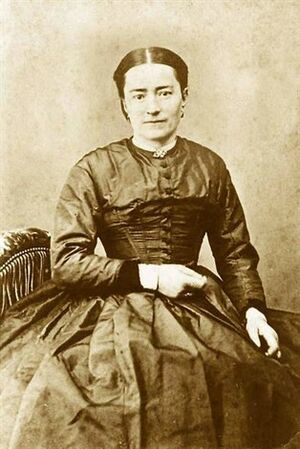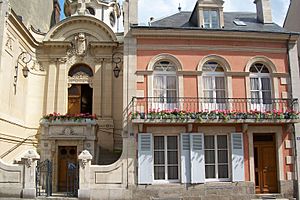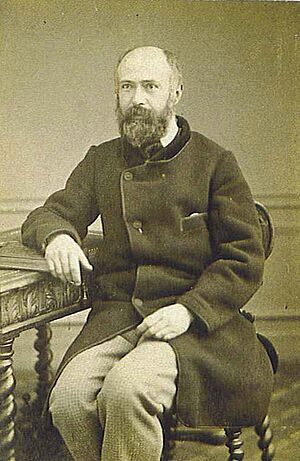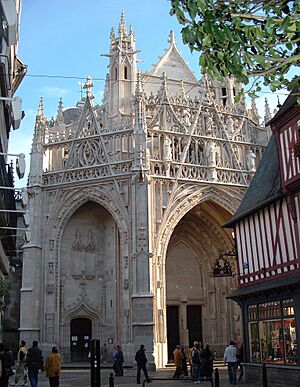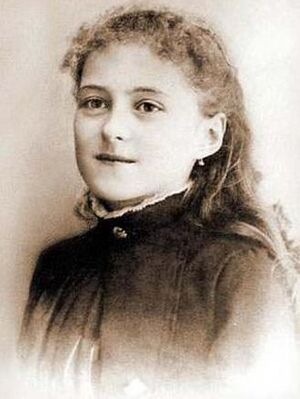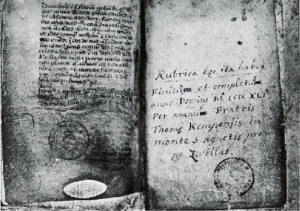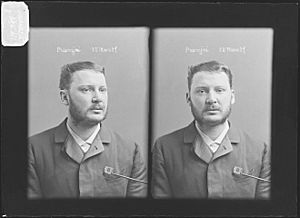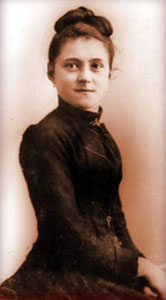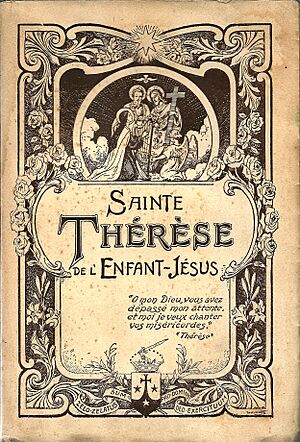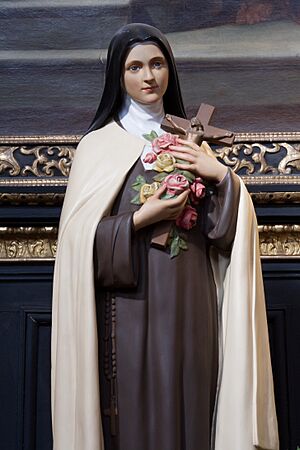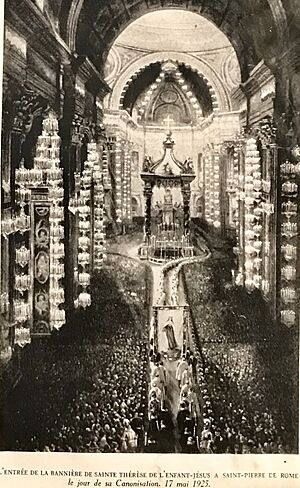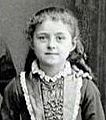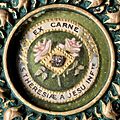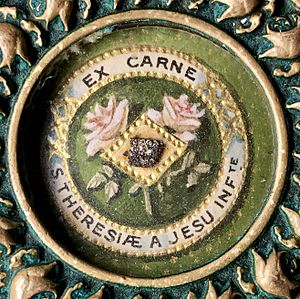Thérèse of Lisieux facts for kids
Quick facts for kids SaintTherese of the Child Jesus and the Holy Face OCD |
|
|---|---|
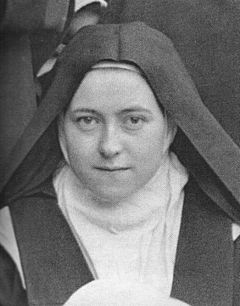
Saint Therese of the Child Jesus
|
|
| Doctor of the Church, Virgin | |
| Born | Marie Françoise-Thérèse Martin 2 January 1873 Alençon, Orne, France |
| Died | 30 September 1897 (aged 24) Lisieux, Calvados, France |
| Venerated in | Catholic Church Anglican Communion |
| Beatified | 29 April 1923 by Pope Pius XI |
| Canonized | 17 May 1925 by Pope Pius XI |
| Major shrine |
|
| Feast |
|
| Attributes | Discalced Carmelite habit, crucifix, roses |
| Patronage | Missionaries; France; Russia; HIV/AIDS survivors; florists and gardeners; orphaned children; homeless peoples; tuberculosis; the Russicum; Alaska; Pasay; Antipolo; Santa Teresita, Batangas; Pueblo, Colorado; Fresno, California; Cheyenne, Wyoming; Kisumu; Witbank; Gardens of Vatican City; Archdiocese of Trivandrum |
Thérèse of Lisieux (born Marie Françoise-Thérèse Martin; January 2, 1873 – September 30, 1897) was a French Catholic Carmelite nun. She is also known as Saint Therese of the Child Jesus and the Holy Face. Many people today admire her. In English, she is often called the Little Flower of Jesus or simply the Little Flower.
Thérèse is a very popular saint in the history of the Church. She is known for her simple and practical way of living a spiritual life. Pope Pius X even called her "the greatest saint of modern times."
Thérèse felt a strong desire to become a nun from a young age. In 1888, when she was just 15, she joined the Carmelite community in Lisieux, Normandy. Two of her older sisters were already there. She spent nine years as a Carmelite nun. For the last year and a half of her life, she felt like Jesus was absent and doubted God's existence. This is sometimes called a "night of faith." Thérèse died at 24 from tuberculosis.
Her feast day is October 1st. The Basilica of Lisieux is the second most popular pilgrimage site in France.
Contents
Saint Therese of Lisieux
Her Early Life
Family and Home
Therese was born on January 2, 1873, in Alençon, France. Her parents were Louis and Zélie Martin. Louis was a jeweler and watchmaker. Both her parents were very religious Catholics. They were the first married couple to be made saints together by the Roman Catholic Church in 2015.
Louis wanted to become a monk but couldn't because he didn't know Latin. Zélie wanted to help the sick as a nun, but she was told no. Instead, she became a skilled lacemaker and started her own business.
Louis and Zélie married in 1858. They had nine children, but only five daughters survived. All five became nuns. Besides Therese, her sisters were:
- Marie (Sister Marie of the Sacred Heart)
- Pauline (Mother Agnes of Jesus)
- Léonie (Sister Françoise-Thérèse)
- Céline (Sister Geneviève of the Holy Face)
Her father gave his daughters sweet nicknames. Marie was his "diamond," Pauline his "noble pearl," and Céline "the bold one." But Therese was his "little queen."
Childhood in Alençon
When Therese was born, she was very weak. She was sent to live with a wet nurse named Rose Taillé in the countryside. She returned home to Alençon when she was 15 months old. Her family loved her very much. Her mother wrote that Therese would call "Mama!" on every step as she came downstairs.
Therese grew up in a very Catholic home. They went to Mass early in the morning and followed church traditions. They also helped others, visiting the sick and welcoming strangers. Therese was a happy child, but she also cried often. She could have "frightful tantrums" when she didn't get her way. She later admitted she was "far from being a perfect little girl."
In 1876, Therese's mother, Zélie, became very ill with a tumor. She died on August 28, 1877, when Therese was just four and a half years old. Her mother's death deeply affected Therese. She said that "the first part of her life stopped that day." She remembered her mother's last moments and how her happy personality changed. She became shy and sensitive, crying easily.
Moving to Lisieux
Three months after her mother died, Louis Martin moved his family to Lisieux. This was where Zélie's brother, Isidore Guérin, lived. They moved into a nice country house called Les Buissonnets. Therese saw this move as the start of the "second period of my life, the most painful." In Lisieux, her sister Pauline became like a "Mama" to Therese. Therese grew very close to Pauline and Céline.
School Days
Therese was taught at home until she was eight and a half. Then she went to a school run by Benedictine nuns in Lisieux. She was a good student, but because she was young and smart, some older girls bullied her. This made Therese very sad, and she cried quietly. She didn't like the noisy games at school and preferred to tell stories or look after younger children. She said her five years at school were the "saddest of my life."
In October 1882, her sister Pauline, who was like a second mother to her, entered the Carmelite convent in Lisieux. Therese was heartbroken. She understood that Pauline would not come back. She wanted to join too, but she was too young.
A Time of Sickness
Around this time, Therese often got sick. She had nervous tremors. Doctors couldn't find a clear cause. In May 1883, she recovered after looking at a statue of the Virgin Mary and seeing her smile. She felt very happy. However, when she told the nuns about it, their questions made her doubt herself. She worried that she had lied, which caused her much distress.
In October 1886, her oldest sister, Marie, also entered the Carmelite monastery. This made Therese even sadder. Only she and Céline were left with their father. Her frequent tears made some people think she had a weak personality. Therese also struggled with scruples, which is when someone worries too much about sinning.
Her Spiritual Journey
A Christmas Miracle
Christmas Eve of 1886 was a very important night for Therese. She called it her "complete conversion." She felt that God helped her grow up instantly. On that night, she overcame the sadness she had felt since her mother's death.
Her family had a tradition of leaving shoes by the fireplace for gifts from the Child Jesus. Therese overheard her father say she was too old for this and that it would be the last year. Instead of crying, Therese suddenly felt strong. She ran downstairs and opened her gifts happily. She felt "charity enter my heart, the need to forget myself to make others happy." She felt she had "recovered the strength of soul she had lost" and would keep it forever.
Wanting to Join Carmel
After her conversion, Therese read The Imitation of Christ, a book about spiritual life. She felt the words were written just for her. She also read about the end of the world and future mysteries. These books helped her a lot.
In May 1887, Therese told her father she wanted to enter Carmel before Christmas. Her father was recovering from a stroke. He picked a small white flower and gave it to her, explaining how God cared for it. Therese felt the flower was a symbol of herself, "destined to live in another soil." She tried to join the Carmel, but the priest said she was too young.
That summer, newspapers reported on Henri Pranzini, a man convicted of murder. Therese prayed hard for him to change his heart before his execution. The newspapers later reported that Pranzini kissed a crucifix three times just before he died. Therese was overjoyed, believing her prayers had saved his soul.

In November 1887, Therese went on a trip to Rome with her father and sister Céline. She met Pope Leo XIII and asked him to let her enter Carmel at 15. The Pope told her to follow what her superiors decided. She refused to leave his feet until she was carried out.
This trip taught her a lot. She saw that priests, though important, were also human and had weaknesses. This made her understand her calling to pray for them. She realized her heart could be easily influenced by the world. Soon after, the Bishop of Bayeux allowed her to join. On April 9, 1888, she became a Carmelite postulant.
Life in the Convent
The Carmelite convent in Lisieux was an old place with strict rules. The nuns focused on prayer. They had only one meal a day for seven months of the year and little free time. Only one room was heated. Therese found peace there. She wrote, "At last my desires were realized, and I cannot describe the deep sweet peace which filled my soul."
Therese worked hard to keep her distance from her sisters in the convent, even though they were together. She wanted to avoid showing favoritism. She said, "I did not come to Carmel to be with my sisters; on the contrary, I saw clearly that their presence would cost me dear." She followed the rules strictly, even the one about not talking much during work.
She chose a spiritual guide, Father Pichon, a Jesuit. He helped her overcome her worries about sin. She also learned to deal with other nuns who sometimes bullied her because she wasn't good at handicrafts. She was the tallest in her family, which led to one nun calling her "the big nanny goat."
In June 1888, her father, Louis Martin, disappeared for a few days. This was the start of his health decline. He died in July 1894.
Becoming a Novice
On January 10, 1889, Therese officially became a novice and received her Carmelite habit. Her father, whose health had improved for a short time, was able to attend. Soon after, he had another stroke and had to go to a special hospital for three years. During this time, Therese grew stronger in her faith. She wanted to live a hidden life, pray for priests, and do small acts of kindness. She called herself a "grain of sand," wanting to be "always littler, lighter, in order to be lifted more easily by the breeze of love."
She read the works of John of the Cross, another Carmelite saint. She learned that love, not fear, was the way to God. She said, "My nature is such that fear makes me recoil, with LOVE not only do I go forward, I fly."
When a Carmelite nun enters the order, she receives a new name. Therese's first name was "of the Child Jesus." Later, she added "of the Holy Face." This name came from her devotion to the suffering face of Jesus during his Passion. She meditated on passages from the prophet Isaiah that described Jesus as having "no beauty" and being "despised." This helped her understand her father's difficult situation and her own desire to be humble.
Her novitiate usually lasted a year, but Therese's was extended. She made her final vows on September 8, 1890, at age 17 and a half. She wrote a prayer for her profession, asking Jesus to help her save many souls and for no soul to be lost that day.
Daily Life as a Carmelite
In the years that followed, Therese matured. She prayed without strong feelings but focused on small acts of kindness. She accepted criticism, even unfair ones, and smiled at nuns who were difficult. She always prayed for priests, especially for those who had left the Church.
She found comfort in the Gospels, which she carried with her. She said, "But it is especially the Gospels which sustain me during my hours of prayer, for in them I find what is necessary for my poor little soul." She looked for Jesus's words to guide her daily life. She realized she didn't need to do "great deeds" to be holy.
Mother Agnes and Her Role
On February 20, 1893, Therese's sister Pauline was elected prioress (leader) of the Carmel and became "Mother Agnes." She made Therese her assistant for guiding the new nuns. Therese taught them the importance of following the rules and obeying God. She said, "Each must act as if the perfection of the Order depended on her personal conduct."
Therese was good at explaining spiritual ideas simply. She used a kaleidoscope to explain the Holy Trinity. She said that if our actions are focused on God's love, they become beautiful, like the patterns in a kaleidoscope. She also used the idea of an elevator to describe God's grace lifting us to heaven. She purposely spent time with nuns she found difficult, seeing it as a way to become more humble.
In September 1893, Therese chose to remain a novice indefinitely instead of becoming a full nun. This meant she would always need permission from others and would not hold important positions. This allowed her to continue caring for the younger nuns.
Therese also wrote two plays about Joan of Arc, her childhood hero. These plays were performed by the nuns for special occasions. In 1894, Pope Leo XIII began the process to make Joan of Arc a saint. On July 29, 1894, Therese's father, Louis Martin, passed away.
The "Little Way"
Therese wanted to become a saint. But after six years in Carmel, she felt small and insignificant. She realized she couldn't achieve holiness through her own great efforts. She understood that she needed God's help because of her smallness. She found a passage in the Book of Proverbs that spoke to her: "Whosoever is a little one, let him come to me."
She believed that to show her love of God, she didn't need to do heroic acts. She wrote, "Love proves itself by deeds, so how am I to show my love? Great deeds are forbidden me. The only way I can prove my love is by scattering flowers and these flowers are every little sacrifice, every glance and word, and the doing of the least actions for love."
This idea became known as the little way. Therese herself called it "my way" and said it was "all confidence and love." She explained that she didn't understand complicated spiritual books. She preferred the simple words of the Bible. She found that "it is enough to recognize one's nothingness and to abandon oneself, like a child, into God's arms." She rejoiced in being little, because "only children, and those who are like them, will be admitted to the heavenly banquet."
Merciful Love
In 1895, Therese felt inspired to offer herself as a sacrifice to God's merciful love. She wrote a special prayer called an 'Act of Oblation' for herself and Céline. She wrote, "In the evening of this life, I shall appear before You with empty hands, for I do not ask You Lord to count my works." She believed that if she fell due to weakness, God's glance would cleanse her soul.
In August 1895, her cousin, Marie Guerin, also joined the convent. Therese's sister Léonie became a nun in a different order.
Therese believed her calling was to pray for priests. She wrote, "Our mission as Carmelites is to form evangelical workers who will save thousands of souls whose mothers we shall be." She prayed for a young priest, Adolphe Roulland, and a seminarian, Maurice Bellière, who were missionaries. She never met them but wrote letters to them, offering encouragement and teaching them about her "little way."
Final Years and Death
Therese's health slowly got worse. She faced her decline bravely. In 1896, after a strict fast, she coughed up blood. She knew this meant she had tuberculosis and would die. She felt happy, believing Jesus was calling her.
She wanted to join a Carmelite mission in French Indochina but couldn't because of her illness. Tuberculosis slowly weakened her. Near the end, her suffering was intense. She said, "I would never have believed it was possible to suffer so much, never, never!" She received her last communion on August 19, 1897. She died on September 30, 1897, at age 24. Her last words were, "My God, I love you!"
Therese was buried on October 4, 1897, in the municipal cemetery in Lisieux. Later, her remains were moved to the Carmel of Lisieux. The statue of Therese in the glass coffin is not her actual body but a statue based on drawings and photos by her sister Céline. It contains some of her bones.
Her Spirituality and Legacy
The Story of a Soul
Therese is best known for her spiritual memoir, Histoire d'une âme (Story of a Soul). It is a collection of three writings. The first was about her childhood, written in 1895 because her sister Pauline (Mother Agnes) asked her to. The second was a letter in 1896, where she explained her "little doctrine" at her sister Marie's request. The third was another memoir in 1897, with more details about her life as a nun.
Therese allowed Pauline to make changes to her writings. Pauline edited the book a lot and presented it as a biography. It was first sent to other Carmelite convents after Therese's death. But it became very popular, with copies being shared widely.
Since 1973, new editions of Therese's original, unedited writings have been published. These include The Story of a Soul, her letters, poems, prayers, and plays.
Devotion to the Holy Face
Therese had a special devotion to the Holy Face of Jesus. This devotion focuses on the disfigured face of Jesus during his suffering. She joined a group dedicated to this devotion in 1885. Her parents also prayed at the place where this devotion began in Tours.
When Therese became a nun, she added "of the Holy Face" to her name. She saw her devotion to the Child Jesus and the Holy Face as connected. She signed her name "Thérèse de l'Enfant Jesus de la Sainte Face." She believed that by thinking about Jesus's suffering, she could become more like him. She wrote, "Make me resemble you, Jesus!"
Therese wrote many prayers about the Holy Face. In one poem, she said, "Jesus, Your ineffable image is the star which guides my steps. Ah, You know, Your sweet Face is for me Heaven on earth." She also wrote the Holy Face Prayer for Sinners, asking God to forgive sinners because of Jesus's sacrifice. Her writings helped spread this devotion around the world.
Recognition and Sainthood
Becoming a Saint
The Story of a Soul had a huge impact after Therese's death. Pope Pius XI called her the "star of his pontificate."
The process to make her a saint began in 1914. Pope Benedict XV sped up the process. In 1921, she was declared "Venerable" (meaning her virtues were heroic). She was beatified (declared "Blessed") in 1923.
Therese was made a saint on May 17, 1925, by Pope Pius XI, just 28 years after her death. Her canonization celebration was huge, with over 60,000 people inside St. Peter's Basilica and 500,000 pilgrims outside.
She quickly became one of the most popular saints of the 20th century. Her feast day was set for October 3rd in 1927. In 1969, it was moved to October 1st, the day after she died.
Therese of Lisieux is the patron saint of missionaries, France, and florists. In 1927, Pope Pius XI named her a co-patron of the missions with Saint Francis Xavier. In 1944, Pope Pius XII made her a co-patron of France with Saint Joan of Arc.
On October 19, 1997, Pope John Paul II declared her a Doctor of the Church. This is a special title given to saints who have made important contributions to theology. She is the youngest person and one of only four women to receive this title.
Her Parents' Sainthood
Therese's parents, Zélie and Louis Martin, were the first married couple to be proposed for sainthood together. In 2004, a miracle was recognized: an Italian child with a lung disorder was cured after prayers to them. They were beatified (declared "Blessed") on October 19, 2008, in Lisieux.
Another miracle, the healing of a newborn girl in Spain, was investigated. Louis and Zélie Martin were made saints on October 18, 2015.
Her Sister Léonie's Sainthood Cause
Therese's older sister, Léonie Martin, is also being considered for sainthood. Léonie was the only one of the five sisters who did not become a Carmelite. She tried to join religious life three times before finally succeeding in 1899. She became Sister Françoise-Thérèse in the Visitation convent in Caen. She followed Therese's "little way." She died in 1941. The process to declare her "Venerable" began in 2015. She is now called Leonie Martin, Servant of God.
Images for kids
-
Leo XIII – in November 1887 when Therese met him, he was seventy-seven.
-
Statue of Saint Therese of Lisieux at the Church of Our Lady Victorious, Prague
-
The National Shrine of the Little Flower Basilica in San Antonio, Texas, United States, built in 1931.
-
With more than two million visitors a year, the Basilica of St. Thérèse in Lisieux is the second-largest pilgrimage site in France, after Lourdes.
-
Detail of a first-class carne relic of Saint Therese of Lisieux
Memorial Sites and Devotion
Places to Visit in Lisieux
Lisieux, where Therese lived most of her life, is now a popular place for pilgrims. About one million visitors come each year.
The Basilica of St. Thérèse in Lisieux was opened in 1954. It is a major center for pilgrims from all over the world and can hold 3,000 people.
Other important places in Lisieux include:
- The Carmel of Lisieux, where her relics are kept.
- Les Buissonnets, the family home where Therese grew up.
- St. Peter's Cathedral, where Therese went to church as a child.
- The cemetery of Lisieux, where she was first buried.
Relics and Their Journeys
The relics of Saint Therese have traveled around the world since 1994. These tours include not only small pieces of her remains but also her religious habit and rosary. Her relics visited Ireland and Canada in 2001. In 2009, they visited England and Wales, including an Anglican church, and a quarter of a million people came to see them.
In 2008, astronaut Ron Garan took a relic of Saint Therese into space on the Space Shuttle Discovery. This was inspired by Therese's wish to "preach the Gospel on all five continents simultaneously."
In 2010, her relics visited South Africa during the FIFA World Cup. In 2013, her writing desk from Carmel toured the United States. The National Shrine of St. Therese in Darien, Illinois, has the largest collection of her relics and personal items outside of Lisieux.
Churches and Shrines Around the World

Many churches and shrines around the world are named after Saint Therese. Some examples include:
- Cathedrals in Honolulu, Hawaii; Bacabal, Brazil; Hamilton, Bermuda; Urawa, Japan; and Changchun, China.
- Basilicas and shrines in Royal Oak, Michigan; San Antonio, Texas; Darien, Illinois; Juneau, Alaska; Pasay, Philippines; and Cairo, Egypt.
Works Inspired by Therese
Many films and music pieces have been created about Therese's life and spirituality.
Films
- 1929: The Miraculous Life of Thérèse Martin by Julien Duvivier.
- 1986: Thérèse by Alain Cavalier, which won several awards.
- 2004: Thérèse: The Story of Saint Thérèse of Lisieux by Leonardo Defilippis.
Music
- An opera called Thérèse was composed by John Tavener in 1969.
- In 1973, José Antônio de Almeida Prado composed an oratorio called Thérèse, l'Amour de Dieu.
- The Carmelite monk Pierre Éliane has released several albums of Therese's poems set to music.
- In 2013, Grégoire released an album called Thérèse – Vivre d'amour, with many famous artists.
See also
 In Spanish: Teresa de Lisieux para niños
In Spanish: Teresa de Lisieux para niños
- Carmelite Rule of St. Albert
- Constitutions of the Carmelite Order
- List of places named after Saint Thérèse of Lisieux
- National Shrine of the Little Flower
- Secular Order of Discalced Carmelites
- St. Theresa of the Child Jesus Church
- Teresa Janina Kierocińska
- Saint Thérèse of Lisieux, patron saint archive


